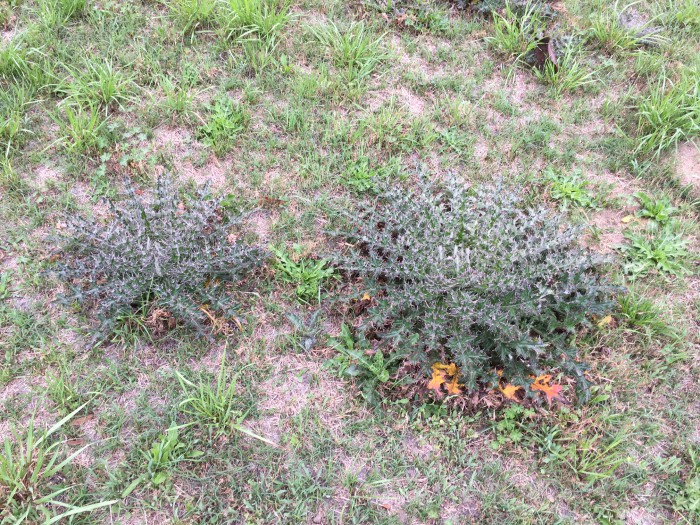
Timing is critical for controlling weeds that infest and invade our pastures. Thistles are an example of a weed in which proper timing of herbicide application can mean the difference between excellent and very poor control of the weed problem. Thistles are biennial, so in year one they come up from seed and form a small rosette, and in year two, they bolt and flower. The thistles in the photo above are still in the rosette stage of development; at this stage they are very easy to control with inexpensive herbicides. A timely application of one of several herbicides in year one, or even early in year two at the beginning of the bolting stage will provide economical control of this weed. However, if you delay treatment until the plant is flowering, control is reduced and more expensive. Often it is the ugly flowers that draw attention to the seriousness of the weed infestation, but scouting for this weed in late winter and early spring can make a huge difference as illustrated in the table below.

It is important to understand that a weed like thistle is very prolific. A single thistle plant can produce 4,000+ seeds. You can rapidly go from a situation where you only have a few plants to a very high populations in one or two years. The good news is that the herbicides available to control thistle will also control many of the winter annual weeds that are out there right now in Panhandle pastures and hayfields. Control measures include 2,4-D, Weedmaster (2,4-D+dicamba) or their generic alternatives, GrazonNext, Pasturegard, Remedy Ultra, or metsulfuron.
One thing to remember is that these herbicides will injure clovers. Some, such as Grazonnext and metsulfuron, have residual activity that may affect clovers that are over-seeded later. Check the label for more information or consult with your local UF/IFAS Extension Agent.
For more information on pasture weed control check out these publications:
Thistle Control in Pastures
Weed management in Pastures and Rangelands – 2016
Other Extension Pasture Weed Fact-sheets
 0
0

Comments:
August 12, 2016
Great article! For the record, Dr. Bill Anderson conducted the research in Tifton. I was a collaborator, but it was Bill and his crew that put in the sweat equity.
March 19, 2016
Do you have a similar for dog fennels? Thank you in advance.
July 30, 2015
Thanks for these good suggestions, Alex.
June 20, 2014
Alex, I really appreciate your professional guidance. To the average person something like this causes panic just based on their look. A white, woolly mass is a great description for them! And as usual, you didn't make me wait for the help I needed! Thanks!
March 26, 2014
The pictures located at http://nwdistrict.ifas.ufl.edu/hort/2014/03/25/titi-in-bloom-this-spring/ are hyperlinked, but when I click on them I receive the following error: 404 - File or directory not found. The resource you are looking for might have been removed, had its name changed, or is temporarily unavailable. Could you please correct this oversight? Thanks. Dixie I.
December 9, 2013
Snails feed on plants but are not harmful to the garden unless present in large quantities. It is probably looking for a place to over winter. Bring a sample to your nearest extension office for ID.
December 8, 2013
Good morning. We found a small snail in the driveway here where we live in N.W. Florida. What do these snails eat? Are they harmful to plants?
Comments are closed.